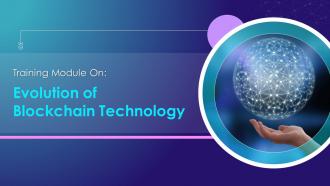Evolution of Blockchain Technology Training Module Training Ppt
This PowerPoint deck in-depth covers the evolution of blockchain technology, covering features and limitations of blockchain 1.0 cryptocurrency, blockchain 2.0 smart contracts, blockchain 3.0 DApps, and blockchain 4.0. It also tabulates the comparison of each version of blockchain technology on factors such as consensus mechanism, scalability, interoperability, speed, cost, and energy consumption. It also contains key takeaways, discussion, and multiple-choice questions related to the topic to make the training session interactive. The PPT training module also includes additional slides on about us, vision, mission, goal, 30-60-90 days plan, timeline, roadmap, training completion certificate, energizer activities, detailed client proposal, and training assessment form.
You must be logged in to download this presentation.
 Impress your
Impress your audience
Editable
of Time
PowerPoint presentation slides
Presenting Training Module on Evolution of Blockchain Technology. This presentation deck contains 75 well-researched and uniquely designed slides. These slides are 100 percent made in PowerPoint and are compatible with all screen types and monitors. They also support Google Slides. Premium Customer Support available. Suitable for use by managers, employees, and organizations. These slides are easily customizable. You can edit the color, text, icon, and font size to suit your requirements.
People who downloaded this PowerPoint presentation also viewed the following :
Content of this Powerpoint Presentation
Slide 4
This slide graphically illustrates the timeline of blockchain technology from 2009 to 2018. It also covers the characteristics of Blockchain 1.0, Blockchain 2.0, and Blockchain 3.0.
Instructor’s Notes:
The multiple blockchain types from 2008 to 2018 in blockchain evolution are as follows:
2008-2013: Blockchain 1.0: Bitcoin Emergence
- In 2008, Satoshi Nakamoto in his white paper showcases the working of blockchain’s first application i.e., Bitcoin
- Satoshi Nakamoto developed the interconnected networks of blocks by creating genesis block
- After the success of bitcoin (cryptocurrency) different industries leveraged the principles and capabilities of blockchain technology
2013-2015: Blockchain 2.0: Ethereum Development
- Vitalik Buterian, an emerging developer, concluded that Bitcoin had not yet reached its full potential
- He started working on a new type of blockchain called malleable blockchain that can perform other and more functions along with the peer-to-peer network
- In 2013, he invented Ethereum as a new public blockchain with added functionalities compared to Bitcoin
- In today's time, the Ethereum blockchain processes the highest number of daily transactions due to its ability to support smart contracts and decentralized applications
2018: Blockchain 3.0: The Future
- In current times, blockchain is not limited to Bitcoin and Ethereum
- New use cases have highlighted some issues with both the previous versions. It enhanced certain features to successfully leverage blockchain capabilities
- Some of the new blockchain applications used in open-source, decentralized, and blockchain platforms are as follows:
- NEO (Cryptocurrency)
- IOTA (Cryptocurrency for Internet of Things)
Slide 5
This slide illustrates that Satoshi Nakamoto developed an interconnected network of blocks by creating genesis block and also explains the important events of Blockchain 1.0 such as the publication of whitepaper by Satoshi Nakamoto in 2008. It also includes details of two digital payment method systems which are cash for the internet and the internet of money that was used by Blockchain 1.0 to increase transparency and public access of global financial systems.
Slide 6
This slide illustrates the disadvantages of blockchain such as use of excess energy, not so vast distributed computing system, no network security, scalability issue, increased complexity, and inefficient.
Slide 7
This slide illustrates the important events of Blockchain 2.0 such as the Vitalik Buterian developing Ethereum in 2013. It also includes details about the introduction of the smart contracts which consists of computer codes shared between participants in the business networks.
Slide 8
This slide illustrates the disadvantages of blockchain such as scalability, interoperability, and governance.
Slide 9
This slide illustrates the important future events of Blockchain 3.0 such as the introduction of NEO (Cryptocurrency), IOTA (Cryptocurrency for Internet of Things). It also includes details about the security and scalability issues addressed by Monero, Zcash and Dash blockchain applications. It also explains the potential of Blockchain 3.0 has to help multiple companies handle data and other sensitive information.
Slide 10
This slide illustrates the disadvantages of Blockchain 3.0. It is not easy to update and fix bugs, KYC is not easy, complex to scale, and few evolved third-party applications.
Slide 11
This slide illustrates the important future events of Blockchain 4.0 that it is a new generation of blockchain technology. Its aim is to ensure that the technology becomes fully usable in mainstream business. It also helps to make technology business-friendly.
Slide 13
This slide illustrates the comparison between Blockchain 1.0 and Blockchain 2.0. They are compared on parameters like types of state, blockchain time, block data, and turing completeness.
Slide 14
This slide illustrates the comparison between Blockchain 1.0 vs. Blockchain 2.0 vs. Blockchain 3.0 vs. Blockchain 4.0. These are compared on parameters like underlying principle, consensus mechanism, verification, scalability, interoperability, intercommunication, speed, cost, energy consumption, example, and application.
Slide 16
This slide depicts the summary of the evolution of the blockchain technology training session. The trainer can use it to highlight the essential concepts of the session to trainees.
Slide 30 to 44
These slides depict energizer activities to engage the audience of the training session.
Slide 46 to 72
These slides include a client training proposal to showcase what the company providing corporate training can accomplish for the client.
Slide 73 to 75
These slides consist a training evaluation form for instructor, content and course assessment.
Evolution of Blockchain Technology Training Module Training Ppt with all 80 slides:
Use our Evolution of Blockchain Technology Training Module Training Ppt to effectively help you save your valuable time. They are readymade to fit into any presentation structure.
-
Great product with highly impressive and engaging designs.
-
SlideTeam provides PPTs on every single topic. Their templates suit my job very well. I am very grateful!








































































































































































